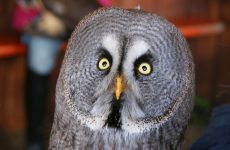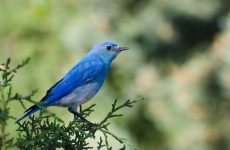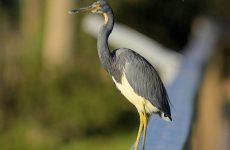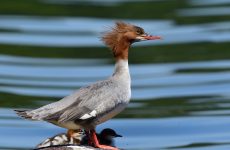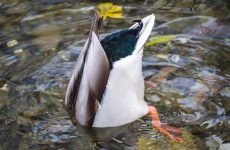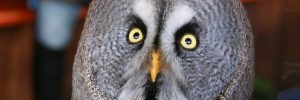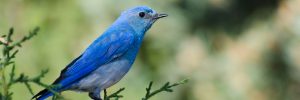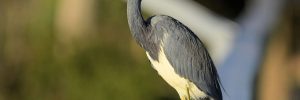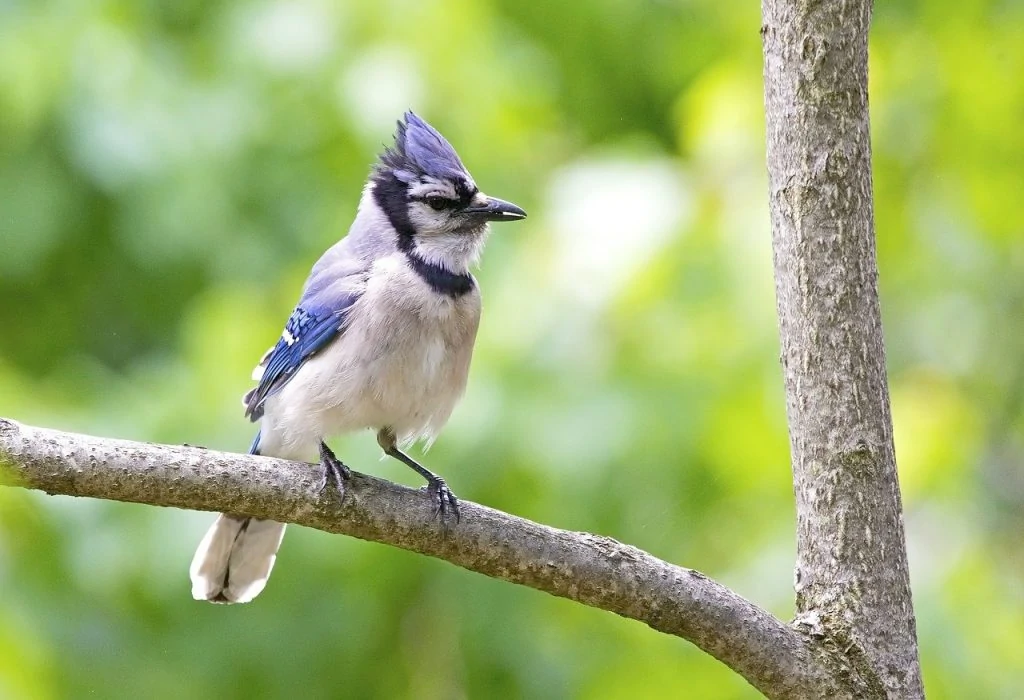
Jays are medium-sized, colorful, and noisy birds that belong to the crow family, Corvidae. There are about 30 to 45 species of jays globally, and 12 of these can be found in North America.
They can be classified into three groups for simplicity. Old World jays are brown-colored from Afro-Eurasia. New World jays are the American Jays and are generally blue, and Gray Jays only have three species in the world.
Jays are shy birds even though they make high, screeching noises in woodland forests. When you hear a jay, it is often because you’ve disturbed them, and now they’re on high alert. They notify other jays and start to move off.
Research has shown that jays can hoard thousands of acorns and store them for winter. While they also feed on other seeds and berries and even small animals like nestlings and bats, they really prefer to eat acorns! They will hold the nuts with their feet and then, with their strong bills, crack the shell open.
Jays are monogamous, meaning they mate for life. The two of them work together to build their nest and become territorial when guarding their growing family.
A group of jays may be called a “band”, “cast”, “party”, and “scold”. This is because they are usually found in noisy groups.
Attract Jays to your backyard with nuts like acorns, peanuts, and sunflower seeds. Just be careful not to linger in their territory while they’re feeding because they can get aggressive.
Use these free bird ID charts to help identify many of the birds that visit your backyard.
12 Jays in North America:
1. Blue Jay
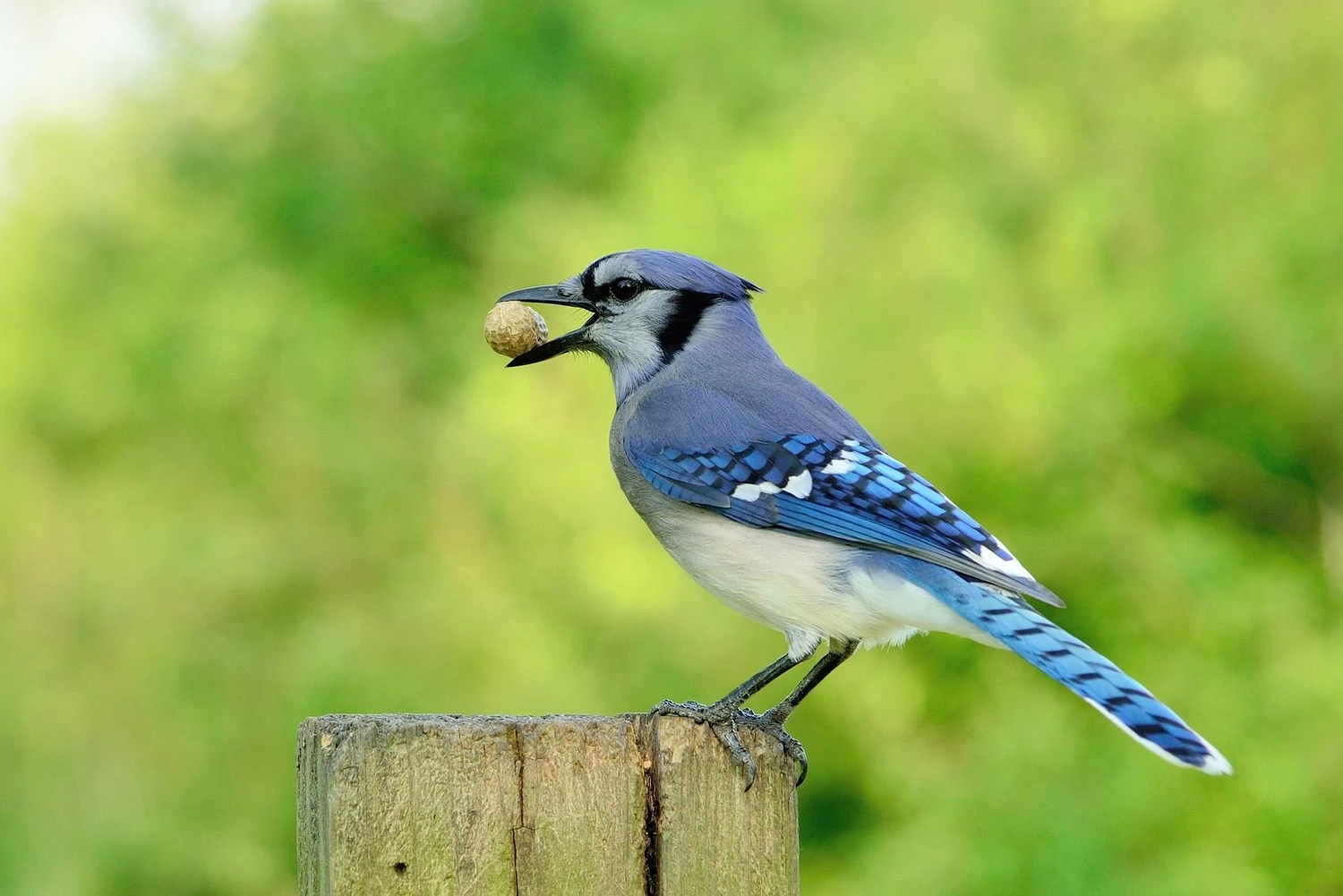
Blue Jays are common large songbirds with a blue upright crest, blue and black backs, and white undersides.
- Cyanocitta cristata
- Length: 9.8-11.8 in (25-30 cm)
- Weight: 2.5-3.5 oz (70-100 g)
- Wingspan: 13.4-16.9 in (34-43 cm)
Blue Jays live in eastern US states and Southern Canada all year. Some birds will migrate west for winter but not very frequently.
They are noisy birds that travel in family groups eating acorns when available. They can be found in forests, mainly near oak, as they eat acorns. They can also be found in backyards near feeders.
As well as acorns, they eat insects, nuts and seeds, and grain. They may also take eggs from nests or take nestlings.
Blue Jay sounds: They usually make a variety of quite harsh calls using clicks, peeps, ‘caws,’ and whistles. Blue Jays also have a gentle fluted song during courtship.
Blue Jays are large birds and prefer to fly in, grab a peanut or sunflower seed and take it away to feed. They prefer platform or tray feeders to make it easy to make a quick exit.
Attract Blue Jays to your backyard with peanuts, sunflower seeds, and suet on tray feeders or hopper feeders on a post. They will also enjoy a birdbath.
Fun fact: Blue Jays will play with shiny objects such as aluminum or bottle caps, and they will carry them around, dropping them and picking them up.
2. California Scrub-Jay
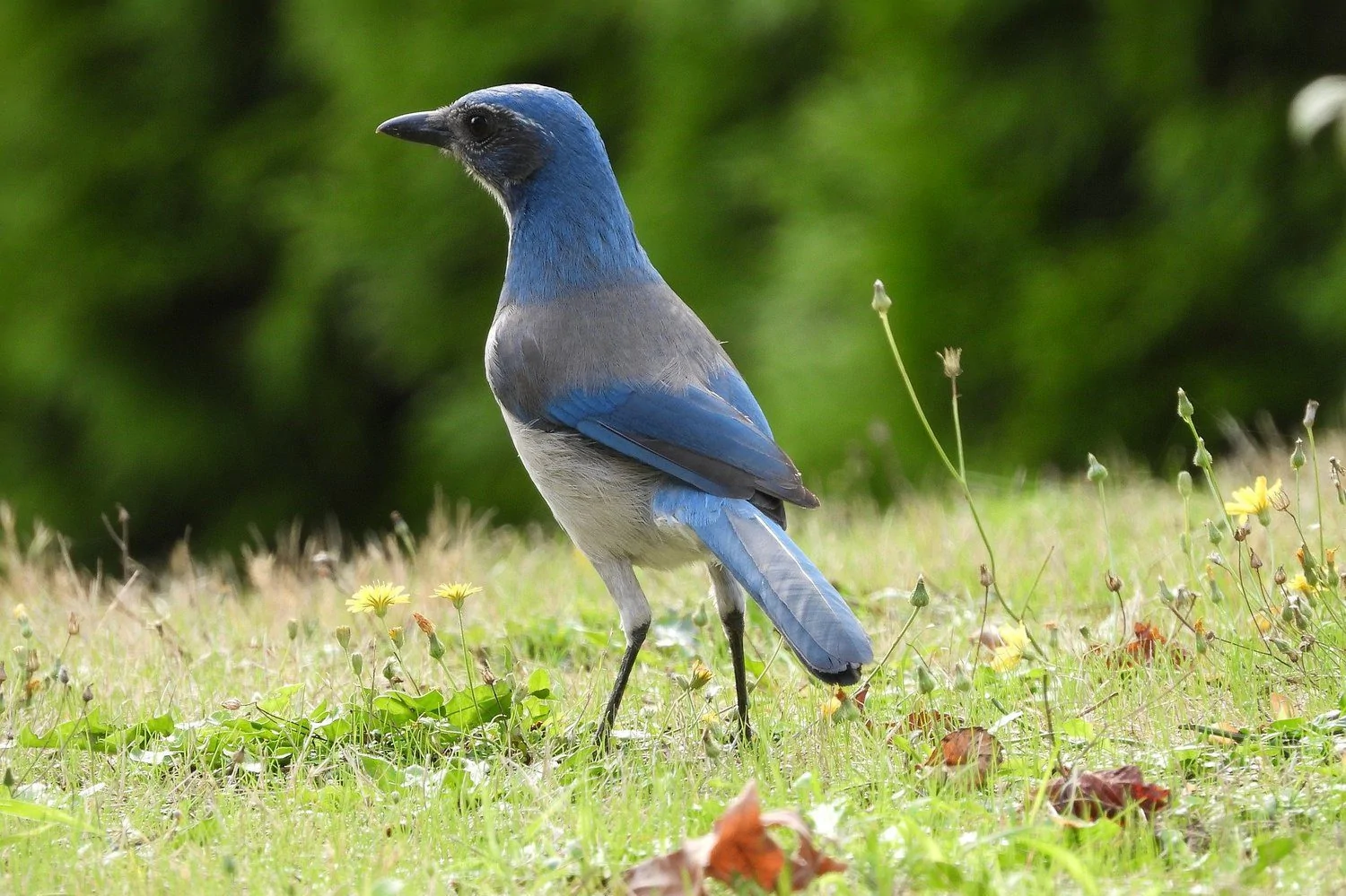
California Scrub-Jays are large songbirds with long tails, whitish undersides and rich blue and gray backs, and a bright blue breast band. They are larger than a robin but smaller than a crow. They look visually similar to the Woodhouse’s Scrub-Jay but with more vivid colors.
- Aphelocoma californica
- Length: 11.0-11.8 in (28-30 cm)
- Weight: 2.5-3.5 oz (70-100 g)
- Wingspan: 15.3 in (39 cm)
California Scrub-Jays are resident all year on the Pacific Coast from British Columbia down to Baja California.
You can find California Scrub-Jay in scrub, oak woodlands, and in suburban yards and parks. They eat insects and fruit during spring and summer and then seeds and nuts, especially acorns, in fall and winter.
California Scrub-Jay sounds: Their call is high-pitched and repetitive. They also sing a courtship song of soft whistles.
Nests of California Scrub-Jay are usually hidden in oak trees and can take up to 10 days to construct the nest made of twigs and a soft lining. They lay 1 – 5 eggs, and the eggs take around 17 – 19 days to hatch.
Attract California Scrub-Jays to your backyard with sunflower seeds and peanuts in your feeders.
Fun fact: California Scrub-Jay will screech over the body of a dead jay and invite others to do the same, and this can last up to half an hour, according to the University of California – Davis
3. Steller’s Jay
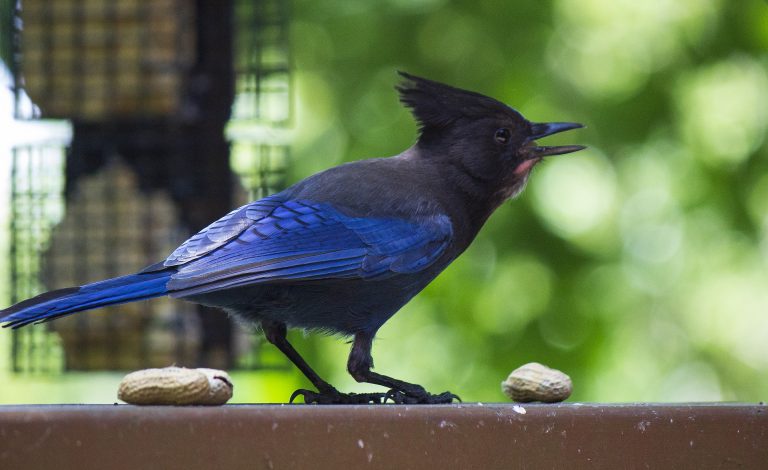
Steller’s Jays are large songbirds with black triangular crests that stick up from their heads. The rest of their heads and onto their chests and back are black, with the rest of their bodies being blue.
- Cyanocitta stelleri
- Length: 11.8-13.4 in (30-34 cm)
- Weight: 3.5-4.9 oz (100-140 g)
- Wingspan: 17.3 in (44 cm)
Steller’s Jays are resident in western US states, western Canada, Mexico, and Central America.
You can find Steller’s Jays in evergreen forests in the mountains, and they will also be found around picnic tables, campgrounds, and backyard feeders.
Steller’s Jays eat most things they can forage for, including insects, seeds, nuts, berries, eggs, and nestlings, but also making a nuisance of themselves around garbage and your unguarded picnic!
Steller’s Jay sounds: They make ‘kaw’ sounds as well as fast two-toned calls, peeps, and harsh guttural sounds. Steller’s Jays can also mimic other noises such as other bird species and even sprinklers and alarms.
Nests of Stellar’s Jays are usually near the top of conifer trees and are built from leaves and plant material held together with mud and lined with soft pine needles.
Attract Steller’s Jays to your backyard with peanuts and suet.
Fun fact: Stellar’s Jays make nests out of the mud.
4. Woodhouse’s Scrub-Jay
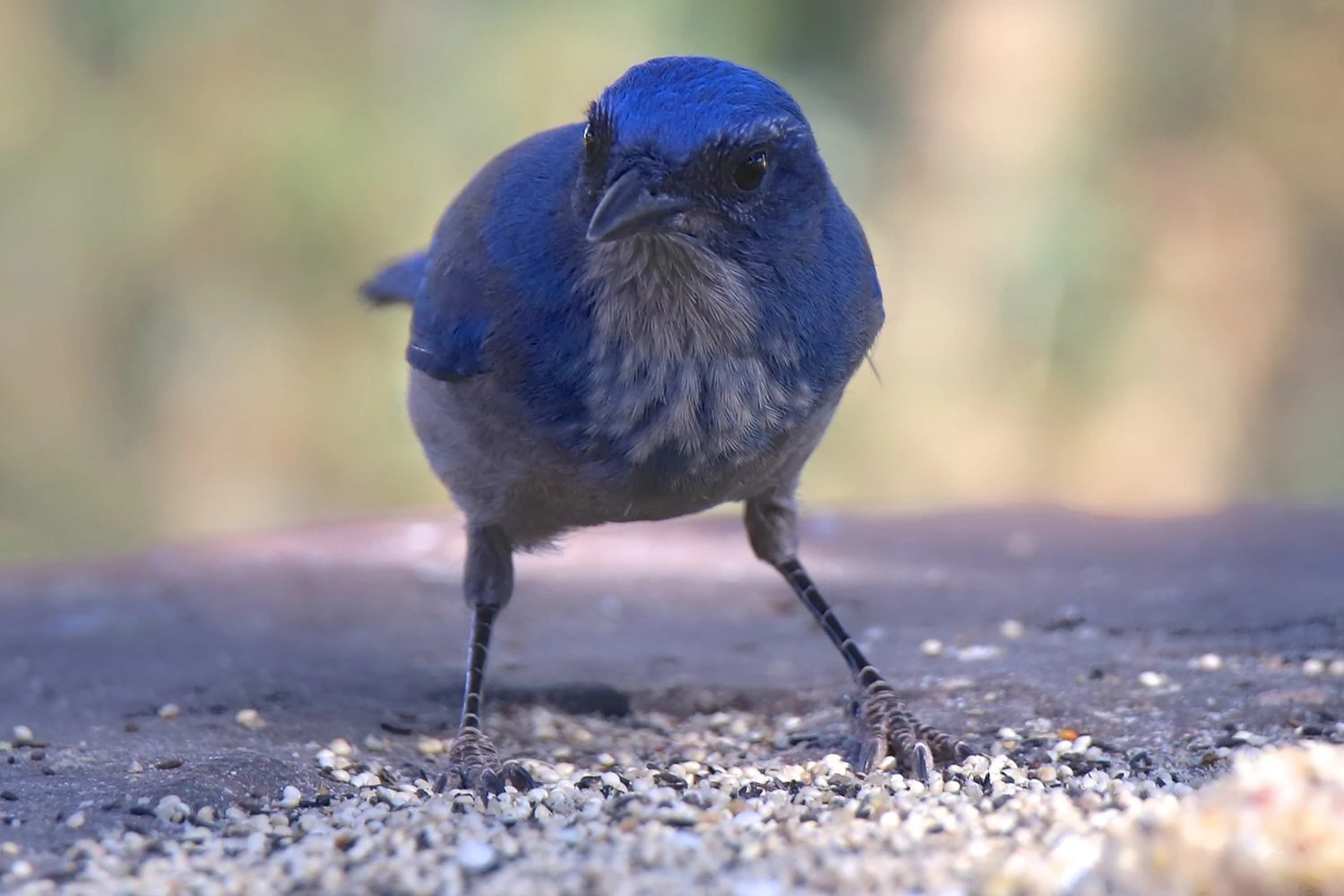
Woodhouse’s Scrub-Jays are the Blue-Jays of the Southwest with lovely blue and gray coloring. They are light blue and dark gray on the back and light gray underneath. Their tails are long and blue.
They are duller in color than California Scrub-Jays and have only a small necklace, and lack the crests of Blue Jays and Stellar’s Jays.
- Aphelocoma woodhouseii
- Length: 11.0-11.8 in (28-30 cm)
- Weight: 2.5-3.5 oz (70-100 g)
Woodhouse’s Scrub-Jays are resident inland in southwest US states and Mexico. You can find them in wooded areas with pinyon-juniper and scrubby areas.
Insects and fruit make up most of the diet of Woodhouse’s Scrub-Jays in summer and nuts and seeds in winter.
Woodhouse’s Scrub-Jay sounds:
Nests of Woodhouse’s Scrub-Jay are fairly simple platforms made of twigs and lined with moss and grass.
Attract Woodhouse’s Scrub-Jays to your backyard with sunflower seeds and peanuts.
Fun Fact: Woodhouse’s Scrub-Jays are thieves that steal food from other birds stores, especially Acorn Woodpeckers’ granary tree store of acorns.
5. Green Jay
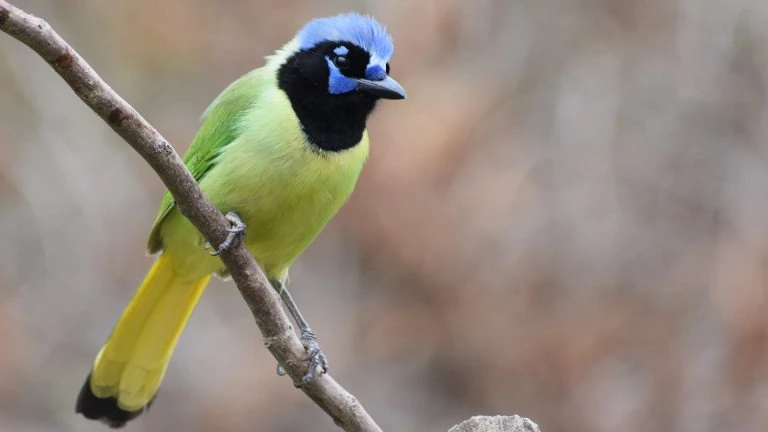
Green Jays are a fantastic mix of bright green, blue, and black. They have dark green backs, paler bellies, and bright blue and black heads.
- Cyanocorax yncas
- Length: 11.4 in (29 cm)
- Weight: 2.3-3.9 oz (66-110 g)
This colorful Green Jay is a rare find in the US as they are only seen in southern Texas. They usually live along the coasts of Mexico, Central America, and South America.
You can find Green Jays in woodlands near streams and water, and they feed on insects, fruit, and seeds. If you are lucky, you may see one at bird feeders in Texan wildlife refuges.
Green Jay sounds: They make a variety of several fast calls that can be ‘Kaw’ like, buzzing, clicking, peeps and screams.
Nests of Green Jays are simple twig constructions lined with moss, leaves, and grass. Even their eggs have a greenish tint to them!
Fun facts: Green Jays are one of a few birds that can use tools, and they will use sticks to help pry up bark to get to food below.
6. Canada Jay
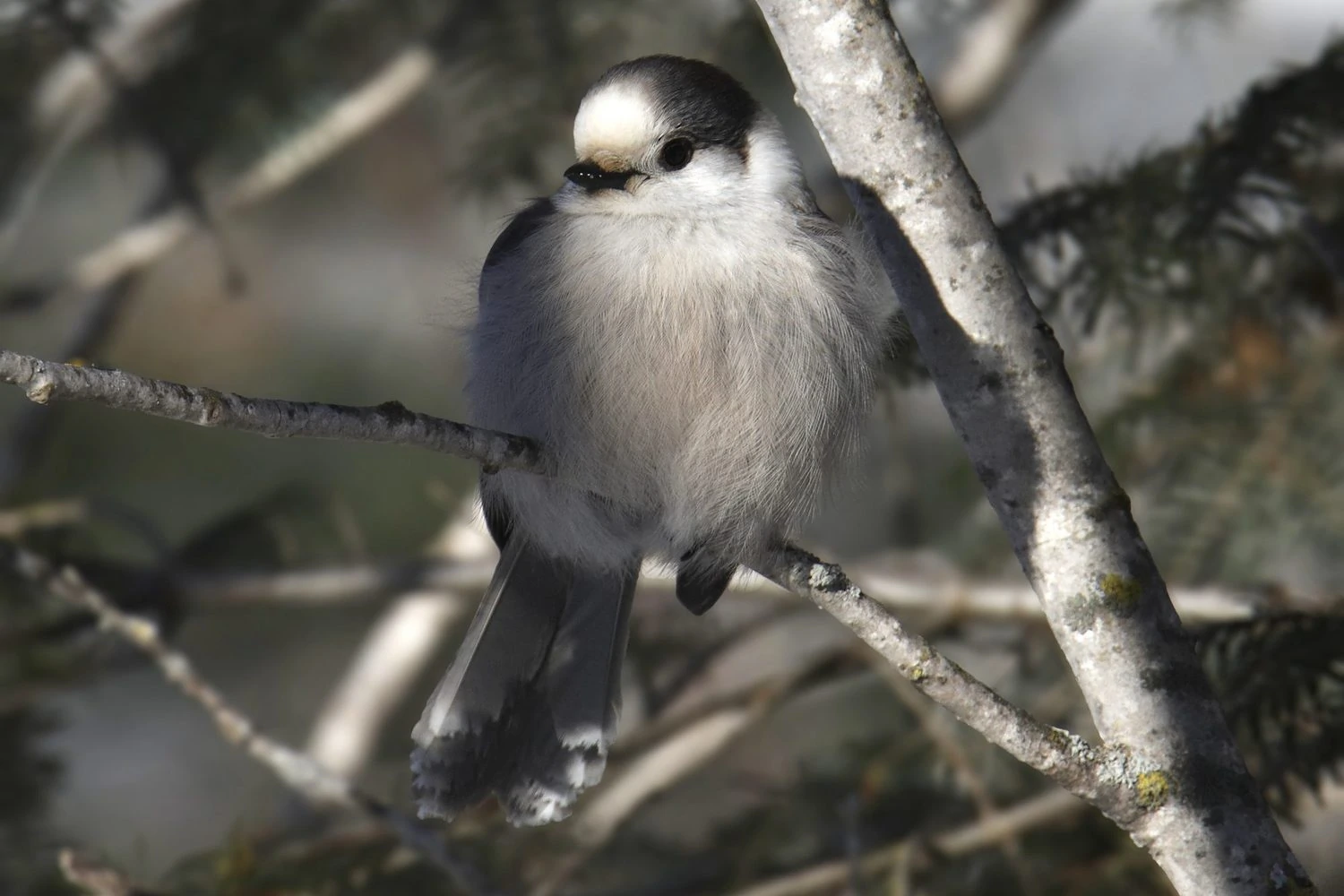
Canada Jays are dark gray on the back and a soft pale gray below. They have white heads and throats, with a black band running around the back of the head.
They are sometimes known as Grey Jays. Females look the same as males, but juveniles are darker gray all over.
- Length: 9.8-11.4 in (25-29 cm)
- Weight: 2.0-3.0 oz (58-84 g)
Canada Jays are resident in Canada, Alaska, and the high mountains of the northwest US. Some color differences occur with Canada Jays from different areas. With those in the Rockies being paler than those in Canada.
You can find Canada Jays in boreal forests where spruce trees are common. They are not as loud as other Jays and are opportunity feeders, eating a wide variety of food, including insects, berries, and dead animals. They will also come close looking for food dropped by hikers.
Although they look sweet, Canada Jays have a deadly side, and they will kill baby birds for food and even hunt smaller species such as chickadees and warblers.
Canada Jay sounds: They have a gentle whispered song but often make harsher calls and clatters. Canada Jays can also imitate other species.
Nests of Canada Jays are built early in conifers when there is still snow around. The nest is made from dead twigs and is lined with feathers and built on the south side of the tree for warmth.
Attract Canada Jays to your backyard with most kinds of bird food, such as seeds and suet, and they will readily eat from tube or platform feeders.
Fun fact: Canada Jays produce special saliva, which they use to mold food into a sticky blob, and then they stick it in a hiding place like gum under a desk.
7. Pinyon Jay
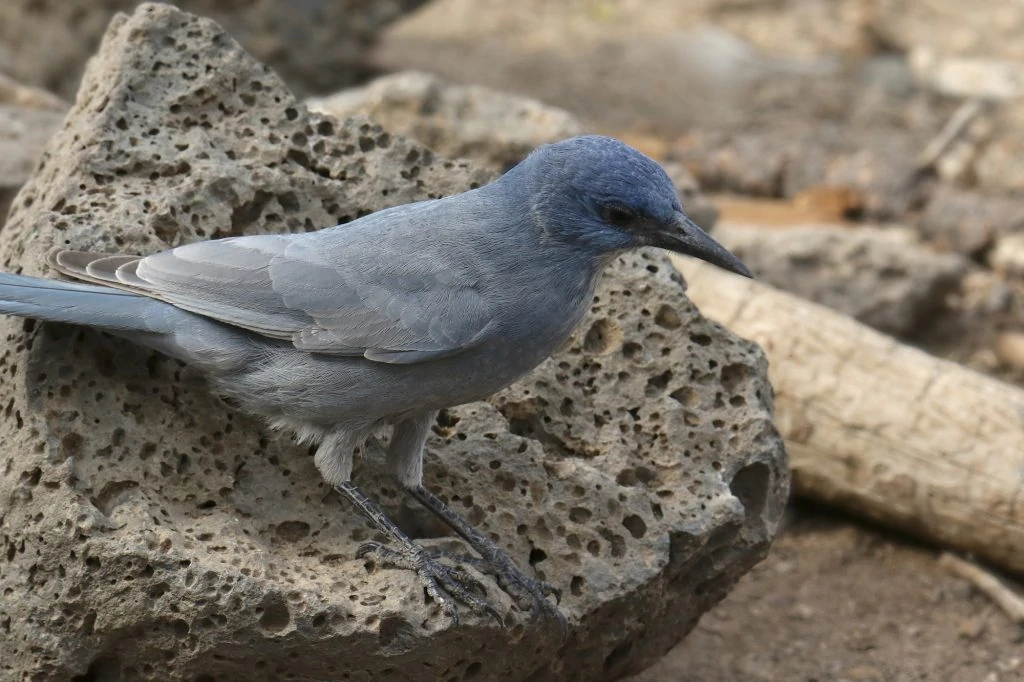
Pinyon Jays are blue all over, with darker backs and paler bellies. They also have white throats, shorter tails, and do not have crests like other Jays, like Stellar’s Jays. Males and females look the same, but juveniles can look more grayish-blue.
- Gymnorhinus cyanocephalus
- Length: 10.2-11.4 in (26-29 cm)
- Weight: 3.2-4.2 oz (90-120 g)
- Wingspan: 18.1 in (46 cm)
Pinyon Jays are resident inland in western US states in pinyon-pine forests.
As well as seeds from pinyon-pine, Pinyon Jays will eat juniper berries, acorns, and other animals such as lizards, baby birds, and insects. They are opportunity feeders who will take most things and forage in large, noisy groups.
Pinyon Jay sounds: They make 3 ‘kaw’ like calls close together that rise and then fall and sometimes shake or tremble.
Nests of Pinyon Jays are built of sticks and grass in pine trees and lined with feathers and animal hair.
Fun fact: Pinyon Jays do not have feathers over their nostrils to prevent the sticky pine pitch from making them dirty.
8. Florida Scrub-Jay
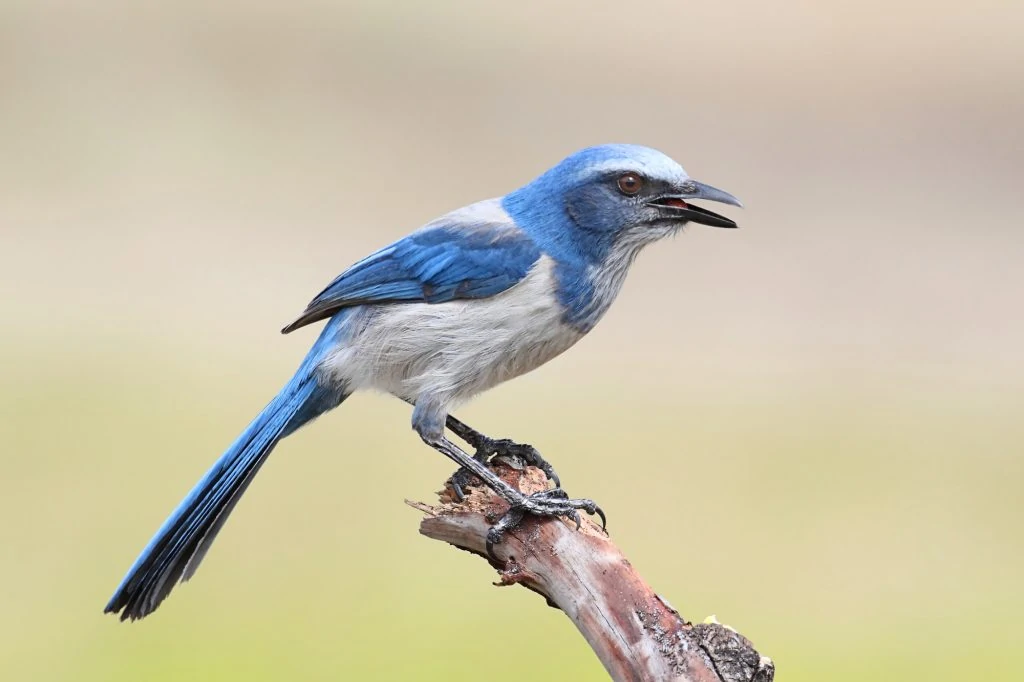
Florida Scrub-Jays are blue, with gray bellies, backs, and foreheads. They have long blue tails and do not have a crest on their heads. Males and females look the same, but juveniles are grayer and have gray heads.
- Aphelocoma coerulescens
- Length: 9.1-11.0 in (23-28 cm)
- Weight: 2.3-3.3 oz (66-92 g)
- Wingspan: 13.0-14.2 in (33-36 cm)
As the name would suggest, Florida Scrub-Jays are found in Florida, and they do not migrate. They are endemic to Florida, meaning they are only native here.
You can find Florida Scrub-Jays in relatively open scrubby areas that are sandy and contain oak scrub. They will be found on the ground looking for insects and berries, and they also eat acorns. They are, however, listed as vulnerable on the ICUN Red List.
Florida Scrub-Jay sounds: They make quite harsh calls and spend a lot of time calling to each other.
Nests of Florida Scrub-Jays are usually in oak trees or shrubs, and they form cooperative flocks, which include young from the previous year. These flocks help protect from predators and feed their young. The offspring then find a territory of their own.
Fun fact: Florida Scrub-Jays break acorns apart by holding them in their feet and using their bills to hammer on the acorn until it breaks open.
9. Black-throated Magpie-Jay
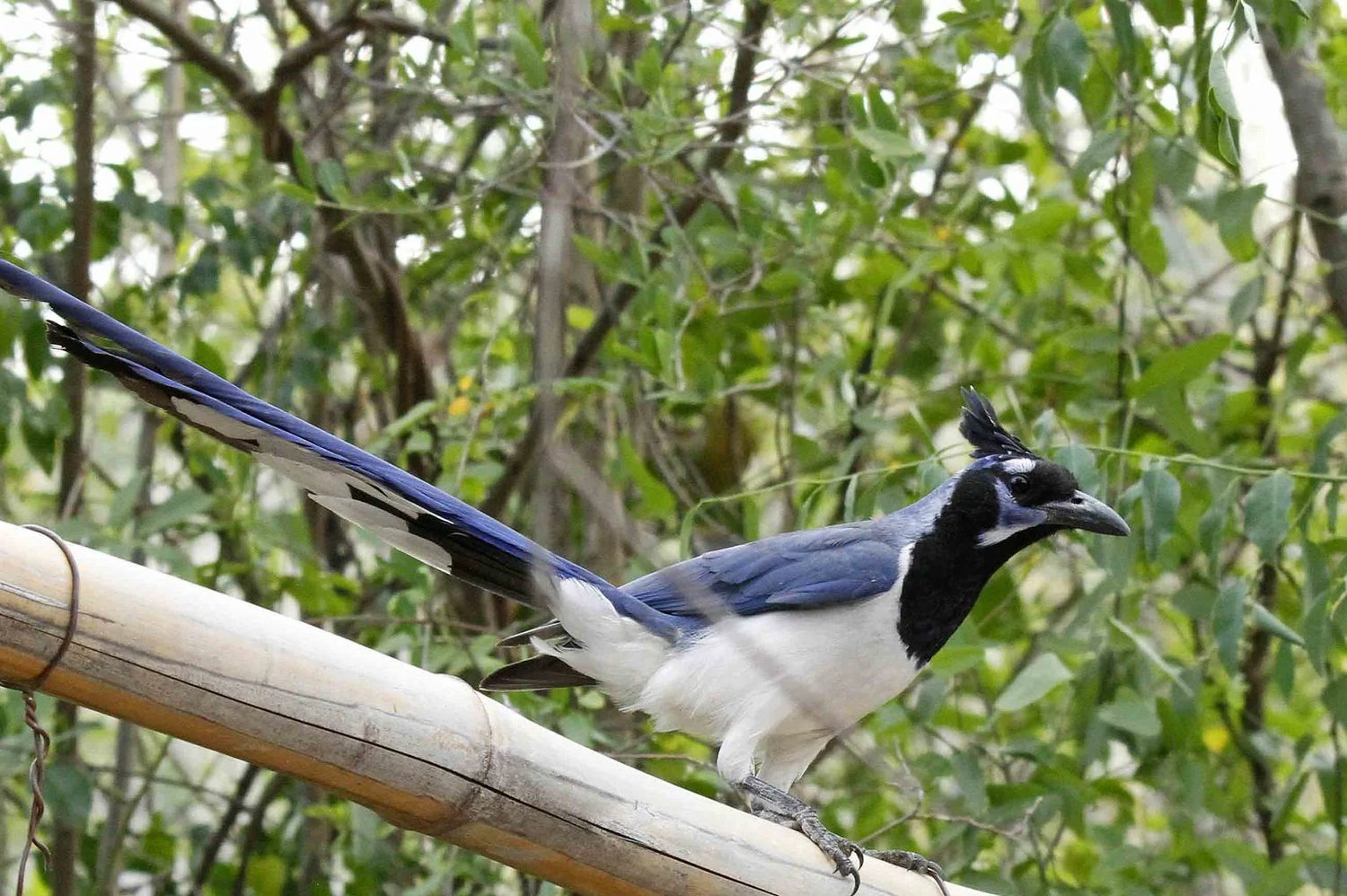
The striking Black-Throated Magpie Jay is a large, long-tailed bird. It has a conspicuous black crest and throat, a patch of blue on its eyebrows and under the eye, blue wings, a white-tipped tail, and a white underside.
In the south of their range, their throats are more white with a thinner black band.
- Calocitta colliei
- Length: 23 – 30 in (58.5 – 76.5 cm)
- Weight: 8 – 9 oz (225 – 251 cm)
You can find Black-throated Magpie Jays around tropical lowland forests, plantations, and partially open areas with tall trees and hedges. They are not particularly fond of humid woodlands, though.
Typical of a crow family, a Black-throated Magpie Jay eats both plants and animals. It loves seeds and nuts but is also known to eat insects and other smaller birds.
Black-throated Magpie-Jay sounds:
Black-throated Magpie-Jays nest is usually created with sticks and twigs but lined with some soft material, and they lay up to seven eggs.
Fun Fact: Black-throated Magpie Jay eats standing up. One foot is used to hold on to the food while the other foot puts food in its mouth.
10. Brown Jay
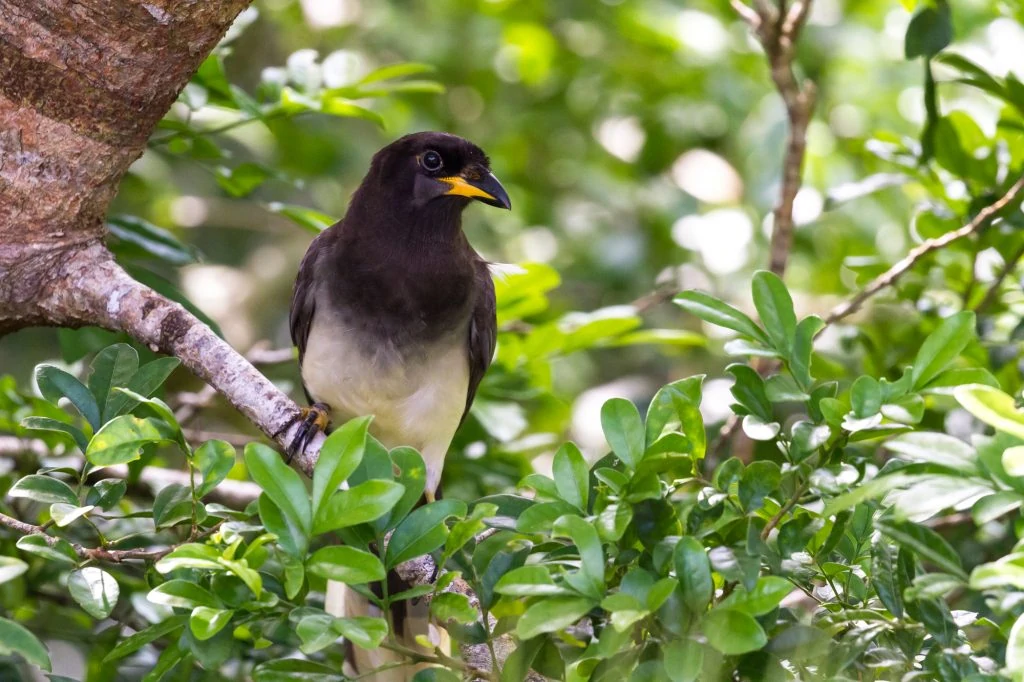
Brown Jays are large birds that can be completely dark brown with a lighter tint on the back, or in some Southern species, their bellies are white, and they have white tips to their tail feathers.
Adults have black bills, legs, and feet, but the young have yellow legs and eyering.
- Psilorhinus morio
- Length: 15 – 17 in (38.1 – 43.2 cm)
- Weight: 7 oz (198.4 g)
Brown Jays are usually found in Mexico and Central America, but they are also found in Texas at the north of their range.
You can find Brown Jays in dense woodland with tall trees and near to water.
Brown Jays are omnivorous, so they will feed on insects and rodents as well as berries, fruits, seeds, and nectar. They will find food on the ground but may also hop from branch to branch.
Brown-Jay sounds:
A flock of Brown Jays share communal nests located in a forked branch of a tree or a low-lying shrub. Several adults put together sticks and twigs to make the cup of the nest, and they line it with weeds and other soft materials for the eggs.
They lay up to eight eggs which take around twenty days to hatch. After hatching, the young leave the nest in about four weeks.
Fun Fact: The Brown Jay is the largest North American Jay.
11. Mexican Scrub-Jay
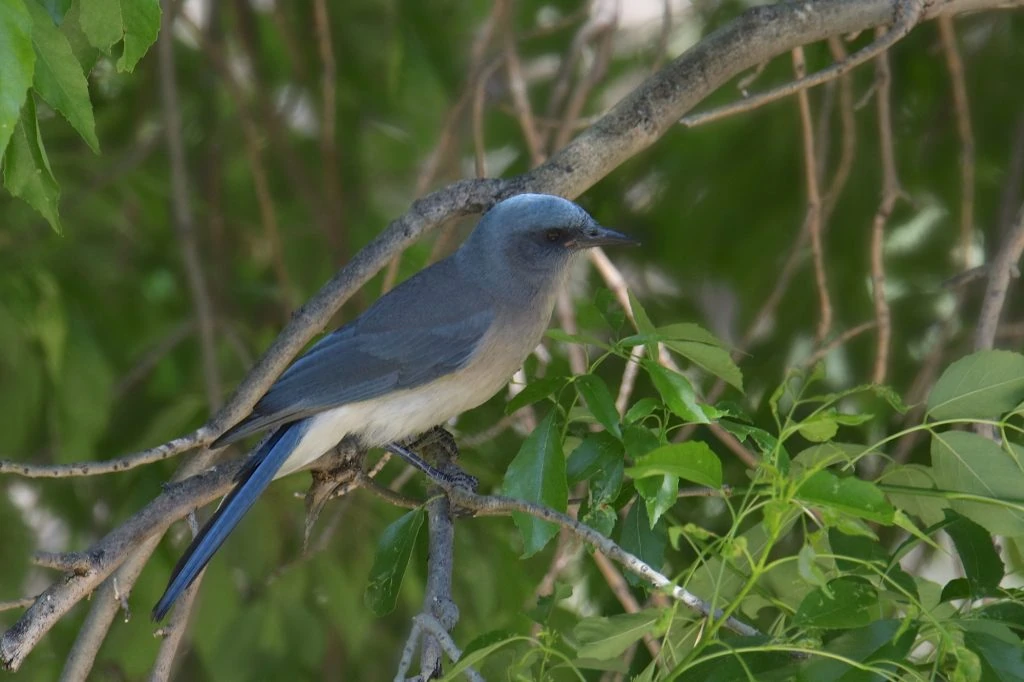
Mexican Jays are medium-sized, pale, bluish-gray birds. It is a lighter color compared to other jays and with a grayish upper neckline and chest. Its bill is small and black.
- Aphelocoma wollweberi
- Length: 11.4 in (29 cm)
- Weight: 4.2-4.8 oz (120-135 g)
You can find Mexican Jays in open oak and pine woods and forests.
Mexican Jays eat mostly insects, small reptiles, and other birds’ eggs and young. In the winter, they mainly eat acorns and pine nuts which they stored during the previous season.
Mexican Scrub-Jay sounds:
Nests of Mexican Jays are built by both males and females in trees and protected by thick leaves. The nests are built of sticks and twigs with a lining of rootlets and plants.
They lay around five eggs that take about eighteen days to hatch. The young leave the nest after about twenty-five days, but they may be cared for by the flock for several weeks.
Fun Fact: Northern Flickers usually follow Mexican Jays in flight during migration because they use the loud, shrill voices of the Mexican Jay to warn themselves of any predators.
12. Island Scrub Jay
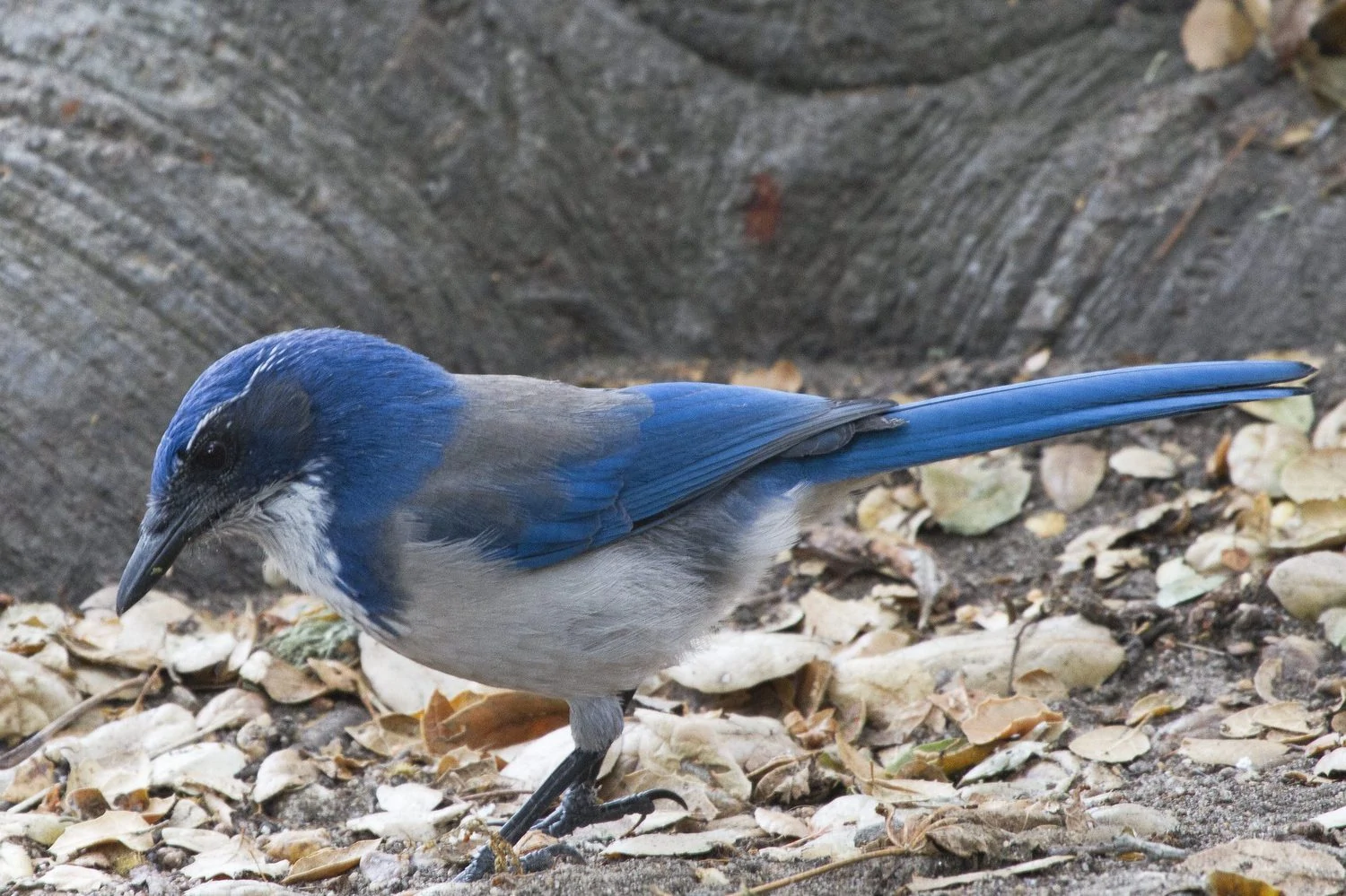
Island Scrub-Jays are large, brightly-colored birds similar to California Scrub-Jays except that their feathers are darker and more richly-colored. They are blue from their head to their tail on the back and gray on top of their wings. They have white throats.
- Aphelocoma insularis
- Length: 11 – 12 in (28 – 33 cm)
- Weight: 4.1 – 4.4 oz (116 – 125 g)
Island Scrub-Jays are permanent residents of Santa Cruz Island, hence their name, and they do not migrate. The island is dominated by oak woodland and chaparral with several streamside thickets and other trees.
The diet of Island Scrub-Jays is mostly insects, small lizards, mice, and even the eggs and young of other smaller birds. In the fall, it feasts on acorns, using its beak to break the shell.
Island Scrub-Jay sounds:
Nest of Island Scrub-Jays are hidden in oak trees. It is sturdy and built with twigs and lined with rootlets and animal hair to keep it soft on the inside. They lay around four eggs, and these take about eighteen days to hatch. As to when the young leave the nest, there’s not a lot of data to know.
Fun Fact: Since the Island Scrub-Jay never leaves Santa Cruz Island, it has the smallest range of any North American bird.

